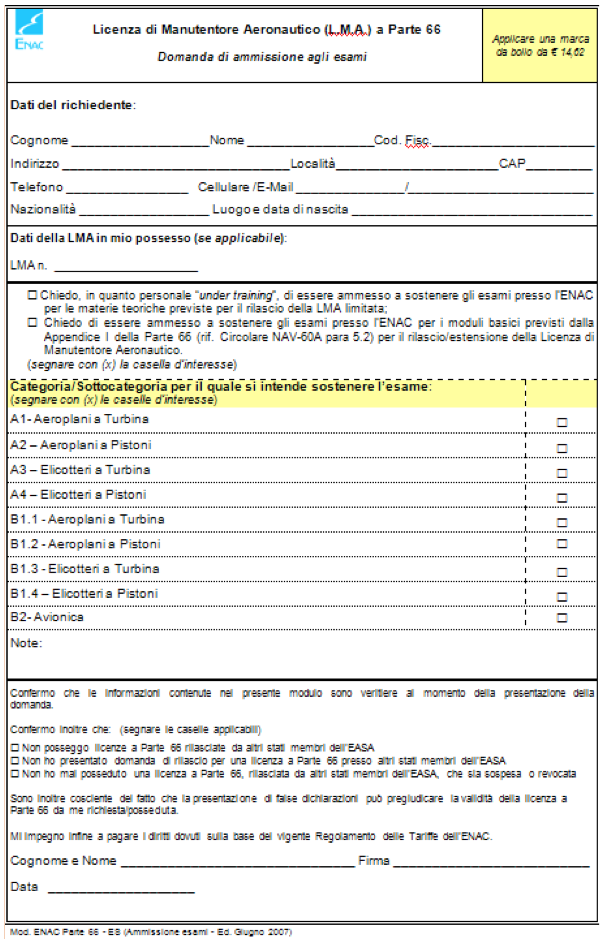Classroom
basic training course
Basic training course Cat. B1.1
Who is the course for?
The classroom basic training course is aimed at all those who wish to pursue a specialized career in the aeronautical sector as maintenance technicians and mechanics for Category B1.1 (turbine engine airplanes), although they have not developed any type of experience in this field.
The contents and levels of knowledge of the course in the classroom comply with the provisions of Annex III (Part 66) of Regulation (EU) 1321/2014.
Our basic training course provides for the theoretical training of the modules and practical training aimed at issuing the “Certificate of Recognition” which attests the participation with a positive outcome to the course, in order to get the Aircraft Maintenance License.
Theoretical Program
Theoretical training consists of 13 modules (as shown in the table to the side) aimed at acquiring the basic technical concepts; for the various topics contained in the individual modules, three different levels of knowledge are provided, each of which defines the objectives that must be achieved in the specific subjects of the individual modules.
A specific course is activated for each module (lectures in Italian). At the end of each theoretical module, the student can take the relative exam. The theoretical exams, in English, consist of a variable number of multiple-choice questions (3 alternatives) and for some modules (M7A-M9A-M10) also with one or two open-ended questions. The grade required to pass the examination of each module must be more than or equal to 75%.
Form | B1.1 |
|---|---|
M1 – Mathematics | |
M2 – Physics | |
M3 – Electrical Fundamentals | |
M4 – Electronic Fundamentals | |
M5 – Digital Techniques | |
M6 – Materials and Hardware | |
M7A – Maintenance Practices | |
M8 – Basic Aerodynamics | |
M9A – Human Factors | |
M10 – Aviation Legislation | |
M11A – Turbine aeroplane aerodynamics, structures and systems | |
M15 – Gas turbine engines | |
M17A – Propeller |
Issue of aircraft maintenance license
The application for the issuance of an Aeronautical Maintenance License (or any changes to this license) must be made using the appropriate form, the AESA Form 19 and submitted to the Competent Authority, in the manner established by the latter.
The application must be accompanied by:
- an Identity Document;
- the Certificates of Recognition proving the passing of the exams related to each module;
- the records of all the practical maintenance activities carried out within the times and in the manner prescribed by the regulations.
Upon receipt of the EASA Form 19 and the documentation, the Competent Authority verifies its completeness and that the level of experience declared complies with the requirements of this part. The Competent Authority also checks the status of the applicant’s exams and/or confirms the validity of the credits to make sure that all the exams of the prescribed modules have been taken according to the regulations.
Once established that the standards of competence and experience of the applicant are in conformity, the Competent Authority issues the relevant Aeronautical Maintenance License.
Practical Program
The practical training involves the performance of maintenance activities on aircraft, engines, propellers and related components in compliance with the procedures contained in the maintenance manuals.
It takes about 1225 hours: of this number of hours, at least 30% will be made at Approved Maintenance Organizations the school cooperates with. The remaining practical part and relative evaluation will be carried out in our laboratories.
Course attendance, as specified by the European standard (ref. 66.A.30 – EU Regulation no. 1321/2014), entitles the holder to a reduction in practical experience from 5 to 2 years, to be carried out on aircraft operating for issue of the Cat. B1.1 license
The practical experience (2 years) must be completed, at the end of the course, in Part-145 or Part M Subpart F Approved Organizations present in EASA Member States or approved according to European standards.
Certificates of passing the examination of the theoretical modules
At the end of the entire course, a single “Certificate of Recognition” is issued which certifies the successful completion of all the theoretical exams and the positive outcome of practical asessments. It must be presented to the Competent Authority for the issue of the License together with the documentation relating to the practical experience gained as established by the regulation. This certificate is valid in all member states of the EASA (European Aviation Safety Agency).
The License is issued only by the Competent Authority (in Italy ENAC) presenting all the necessary documentation and it is recognized in all EASA Member States.
Read more
Course duration:
2450 hours (almost 2 years)
Theoretical training:
1225 hours
Practical training:
1225 hours
Currently, there are no entrance tests to attend the course.
A basic knowledge of English (Level A2/B1) and a secondary school diploma (equivalent or higher educational qualification) are required. A strong aptitude for manual work is recommended.
Registration and costs
Download the flyer about AEA Basic Training Course in PDF format.


